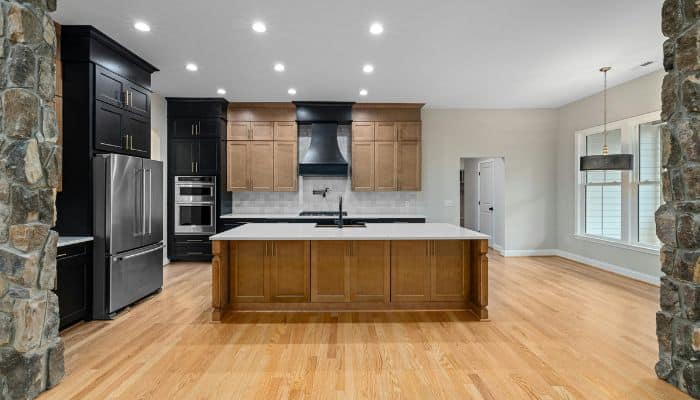Most kitchen remodels overlook one crucial element — lighting. Proper kitchen lighting improves visibility, enhances design features, and creates a comfortable atmosphere for cooking and dining. Yet many remodelers forget to balance ambient, task, and accent lighting, resulting in dark corners and uneven brightness. This guide explains the lighting essentials every remodeler should know to make your kitchen both functional and beautiful.
Why Lighting Can Make or Break Your Kitchen Design
Lighting is more than a decorative choice — it defines how your kitchen functions. Proper illumination enhances visibility for cooking, cleaning, and dining while creating a warm, welcoming atmosphere. Many homeowners realize too late that they’ve spent thousands on finishes that look flat or shadowed due to poor lighting design.
A well-planned kitchen lighting layout ensures that every corner — from your prep zones to the sink area — is both practical and visually pleasing. And yet, even experienced kitchen remodelers can underestimate how different lighting layers impact overall ambiance.
The Three Layers of Kitchen Lighting
Every functional kitchen should have three layers of lighting: ambient, task, and accent lighting. Missing one layer can completely throw off your kitchen’s usability and aesthetic balance.
1. Ambient Lighting:
This is your general illumination — often provided by ceiling-mounted fixtures or recessed lights. Ambient light sets the tone of your space and ensures no area feels dim or gloomy.
2. Task Lighting:
Think of under-cabinet lights or pendant fixtures above the island. These help you perform precise tasks like chopping vegetables, reading recipes, or washing dishes without straining your eyes.
3. Accent Lighting:
Accent lights, such as LED strips inside glass cabinets or toe-kick lighting, add depth and character. They’re essential for highlighting textures, colors, and unique features of your kitchen design.
Balancing these layers properly is one of the top details that kitchen remodel contractors emphasize during a well-planned remodel — yet homeowners often underestimate its importance until the final reveal.
Common Kitchen Lighting Mistakes Remodelers Regret Later
Even the best kitchen remodelers make lighting missteps that can diminish the value of their hard work. Here are a few pitfalls you’ll want to avoid:
1. Overusing recessed lights: Too many can create harsh glare or make ceilings feel cluttered.
2. Ignoring color temperature: Mixing warm and cool lights can throw off your entire kitchen’s tone.
3. Skipping dimmers: Adjustable lighting lets you switch from bright cooking mode to cozy dinner ambiance.
4. Poor placement: Fixtures positioned behind you cast unwanted shadows over your workspace.
5. Forgetting the sink area: This is one of the most used spots in the kitchen, yet often under-lit.
If your sink lighting is inadequate, consider adding under-cabinet or focused pendant lights. You can even explore this helpful guide on how to replace a kitchen sink faucet to enhance both functionality and style in that area.
Choosing the Right Light Fixtures for Your Kitchen Remodel
The style of your fixtures should blend seamlessly with your kitchen design, but functionality should always come first. Here’s how to choose the right lighting types for each area:
Ceiling fixtures: Ideal for ambient lighting in large or open-plan kitchens.
Pendants: Perfect for islands or breakfast bars — choose adjustable heights for versatility.
Under-cabinet lights: These eliminate shadows on countertops and improve task efficiency.
Recessed lights: Use sparingly for clean, modern designs — but ensure proper spacing to avoid dark spots.
Track lighting: Great for angled or hard-to-light layouts.
A key rule: select energy-efficient LED bulbs with color temperatures between 2700K–3000K for a warm, inviting glow. Cooler tones (4000K+) work best in modern or industrial kitchens.
Lighting Placement Tips Every Remodeler Should Know
Strategic placement is just as important as fixture choice. Here are some proven placement tips remodelers often overlook:
-
Space recessed lights 4–6 feet apart for even illumination.
-
Position pendants 30–36 inches above countertops or islands.
-
Mount under-cabinet lights toward the front edge to prevent shadows.
-
Layer lights using separate switches or smart controls for better flexibility.
Avoid placing all lights on one circuit — you’ll lose control over mood and brightness. Zone lighting gives you the flexibility to light up specific areas without overwhelming the space.
Smart Lighting for Modern Kitchens
Smart lighting is no longer a luxury — it’s a must-have feature for convenience and efficiency. Using voice or app control, you can adjust brightness, color temperature, or even schedule lighting scenes throughout the day.
For instance, set cooler tones for meal prep during the day and warmer tones for evening relaxation. This adds not just comfort but also energy savings and longevity to your bulbs.
Smart systems also sync beautifully with modern kitchen remodelers’ designs, offering sleek, hidden setups without messy wiring or manual switches.
Final Touches
Great lighting can transform your kitchen from average to exceptional. It highlights your finishes, brings out textures, and ensures your design investment shines — literally. Whether you’re working with a professional or handling a DIY upgrade, always plan your lighting before the remodel begins, not after.
A well-lit kitchen enhances both function and beauty, creating a space that feels cohesive, comfortable, and built to last.


Recent Comments